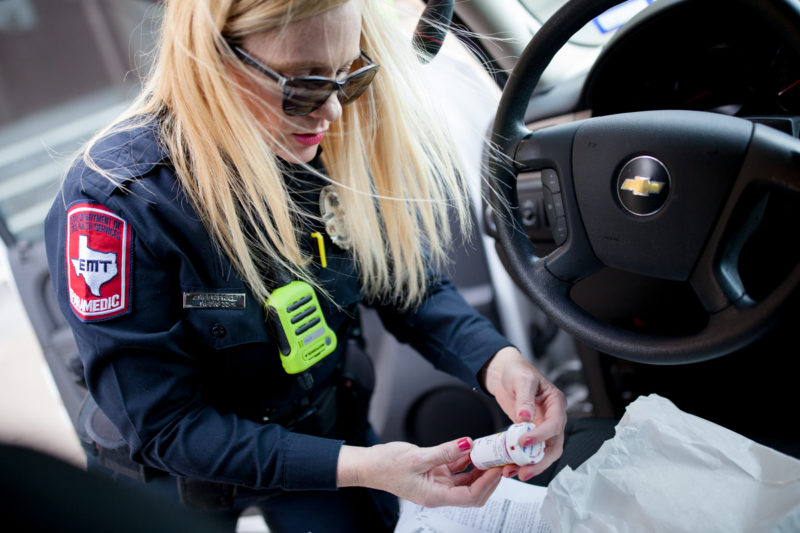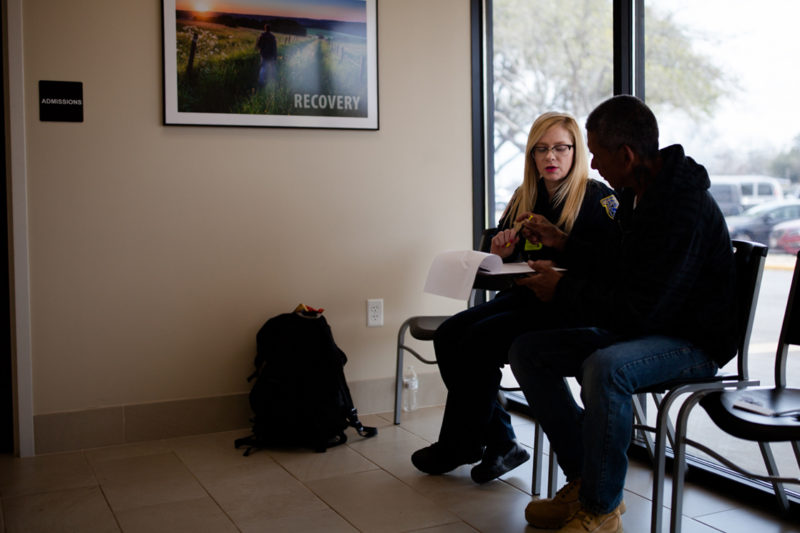Travis EMS Community Outreach Program Helps Reduce 911 Calls
By Taylor Jackson Buchanan
Photography By Austin Price
Reporting Texas

Amber Price, a paramedic with the community health outreach program, checks the medication for a patient on the streets in downtown Austin. Much of her work includes visiting with the homeless and addressing their individual health needs. Austin Price/Reporting Texas
Amber Price examines an assault victim’s head wound. The man, in his mid-20s, was hit with a lead pipe. There’s no ambulance or stretcher in sight as the veteran paramedic asks her patient to rest his hulking, 6-foot-7-inch frame on a wooden picnic table and determines that the days-old laceration is showing signs of infection.
After a few minutes, the man sits up slowly and fingers his long blond hair into a tousled bun, concealing the gash. He has a job interview in an hour and can’t be late; it could be his chance to get off the streets. Price dials a nearby clinic on her cell phone to arrange for further treatment and wishes him luck.
Travis County health officials view encounters like this as the future of emergency medicine. Price wasn’t responding to a 911 call. She was following up with regular clients near Sunrise Community Church in South Austin.
Price is one of seven community health paramedics in the county, part of a program that connects patients with little or no economic safety net – from the home-bound to the homeless – to preventative health care and other basic needs. The paramedics seek both to improve their patients’ quality of life and reduce their reliance on costly emergency services.
“We work in the community. We don’t have an office somewhere and wait for a patient to show up,” said Andy Hofmeister, commander of the program. “We bring the ability to mobilize – anytime, anywhere. At any given moment, we’re working with a patient under an overpass or on the couch in their living room.”
Supporters of preventative emergency care point to Travis County as a success story in the nation’s quest to lower health-care costs. Since forming eight years ago, Hofmeister’s team, whose members average 15 years of experience, has contributed to a 60 percent reduction in emergency calls from the population it serves, which is roughly 1,000 people a year, according to the commander.

Price helps a patient check into an addiction treatment center. The man said he was ready to kick his heroin habit. Austin Price/Reporting Texas
Critics agree that the program is a sensible step toward reducing expensive reliance on acute care. However, some worry that with seven fewer paramedics aboard ambulances, emergency services might be compromised.
“The community health program is good, but it’s not the primary mission of EMS,” said Mike Levy, founder and retired publisher of Texas Monthly who serves on the Austin Public Safety Commission. “The primary mission is responding to emergency calls.”
Austin-Travis County EMS faces reports of low morale among paramedics due to “stupidity and arrogance” of department officials, Levy said, citing the department’s 2012 shift to a “one paramedic, one EMT” model. Before the change, two paramedics, who have more advanced training and skills than EMTs, staffed each ambulance.
Hofmeister said his paramedics are well aware that “staffing ambulances is absolutely the priority.” If a critical shortage were to emerge, the community health team would temporarily rejoin the ambulance crews, he added.
“The angst and fear about a one paramedic, one EMT model crops up from time to time, but it is unfounded,” Hofmeister said. “No one staffs an ER with only doctors; you need nurses and other staff to perform their roles for the best patient outcomes.”
Price and the other community health paramedics do not provide long-term care, officials say, but rather connect patients to resources to meet their individual needs. Common needs include assistance setting up appointments with primary health-care providers, managing prescriptions and arranging transportation to an appointment or a pharmacy.
Most resources that patients need are already established, according to Price.
“They think they’re poor. They’re just not connected,” she said. “The city of Austin is full of resources. It’s a matter of connecting those who are on the fringes.”
One such individual living “on the fringes” is a 57-year-old man who has been unable to work his typical rotation of odd jobs as a carpenter due to persistent knee pain. “I’ve always been able to work my way out in the past. This time, I’m stuck,” said the man, who agreed to be interviewed about his health issues on the condition that he not be identified.
Community health paramedics secured funding for an MRI through Travis County’s medical access program. They scheduled an appointment for the man, provided transportation between a South Austin homeless camp and University Medical Center Brackenridge on the day of the procedure and helped him fill his prescriptions.
“He would have sat in his camp, in pain, unable to work. Eventually, if the pain got severe enough, he might have called EMS,” Price said. “In the ER, they would have given him a list of numbers to call. This would have played out again and again.”
Without life-changing interventions the community health program provides, paramedics responding to emergency calls often see the same patients in their ambulances and the same preventable issues. Every call that’s prevented represents one less $500 bill from EMS and one less ER visit, Hofmeister said.
Because the individuals can’t pay and often are without insurance, the burden of those medical costs falls on taxpayers, according to Michael Lauderdale, a social work professor at the University of Texas at Austin. “In terms of cost containment issues, this is a very important thing the city needs to continue to pay attention to,” he said.
Over half the community health paramedics on this team work with the homeless in an effort to reduce the costs associated with homeless individuals relying on emergency care. A homeless person in Austin averages 37 inpatient hospital stays, 21 emergency room visits and 19 EMS transports every year, amounting to $220,000 in medical costs, according to the Ending Community Homelessness Coalition.
With an EMS budget of $83.8 million and 574 sworn employees, the community health program diverts a fraction of money and personnel from emergency response. The annual budget for the community health program is just over $1 million.

Price works most of her shift out of her EMS SUV to check on patients and take them to appropriate health services. Austin Price/Reporting Texas
Counties and cities across the nation are investing resources into new endeavors such as Austin’s community health model, which was inspired by a program in Fort Worth.
Experts say such programs are needed more than ever. Austin has a growing population of residents with chronic diseases such as hypertension, heart disease and diabetes, according to Dr. Alexandra Garcia, director of community engagement and public health at UT-Austin’s Dell Medical School. The acute care setting isn’t equipped to handle the number of people who lack access to primary care.
“It’s really costly,” Garcia said. “We just can’t afford this. Hospitals and really taxpayers end up paying for acute care when a patient is unemployed. We need healthy students, and we need healthy workers.”
Getting healthy and reentering the workforce is a top priority for a 58-year-old man who says he’s eager to get back to landscaping, painting and roofing.
“Miss Amber, you and I did it,” Price says on a recent afternoon. “We’re finally here.”
They sit on plastic chairs in a stark reception area at an addiction treatment center. Price holds a clipboard and reviews the center’s policies. The man is preparing to detox from what he says is a $150 a day heroin addiction.
“I’ve done made up my mind. I don’t want to be on the streets no more. I need to get all this s—t out of my system. I’m going to get right,” he says.
He has spent over half his life – 30 years – in a penitentiary. When Price met the man last October, he was tucked below an overpass, where the loud noise of cars passing overhead gave him a sense of familiarity, reminding him of prison. She has been trying to get him on the road to recovery for months. Both the system – funding and a bed – and the man had to be prepared — not an easy feat. The man has since entered a detoxification program, with long and difficult days ahead. Price is cautiously optimistic.
“It’s about connecting people to services for long-term care,” she said. “Whatever barrier a client is facing, we’re going to figure out how to get rid of it. There are people, on the very end of the spectrum, who we won’t be able to solve their problem. But the majority are in the middle, and we can figure out how to get them to the right place at the right time.”